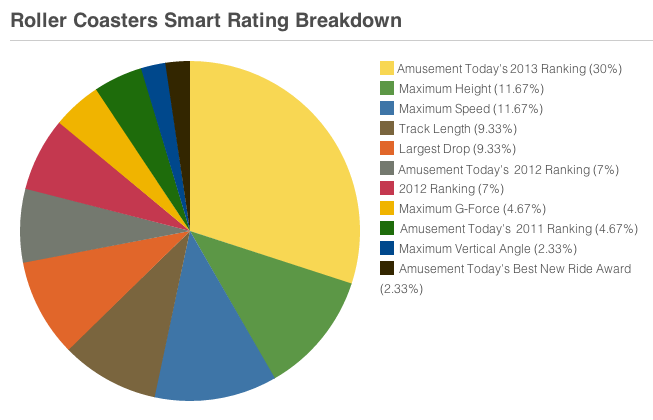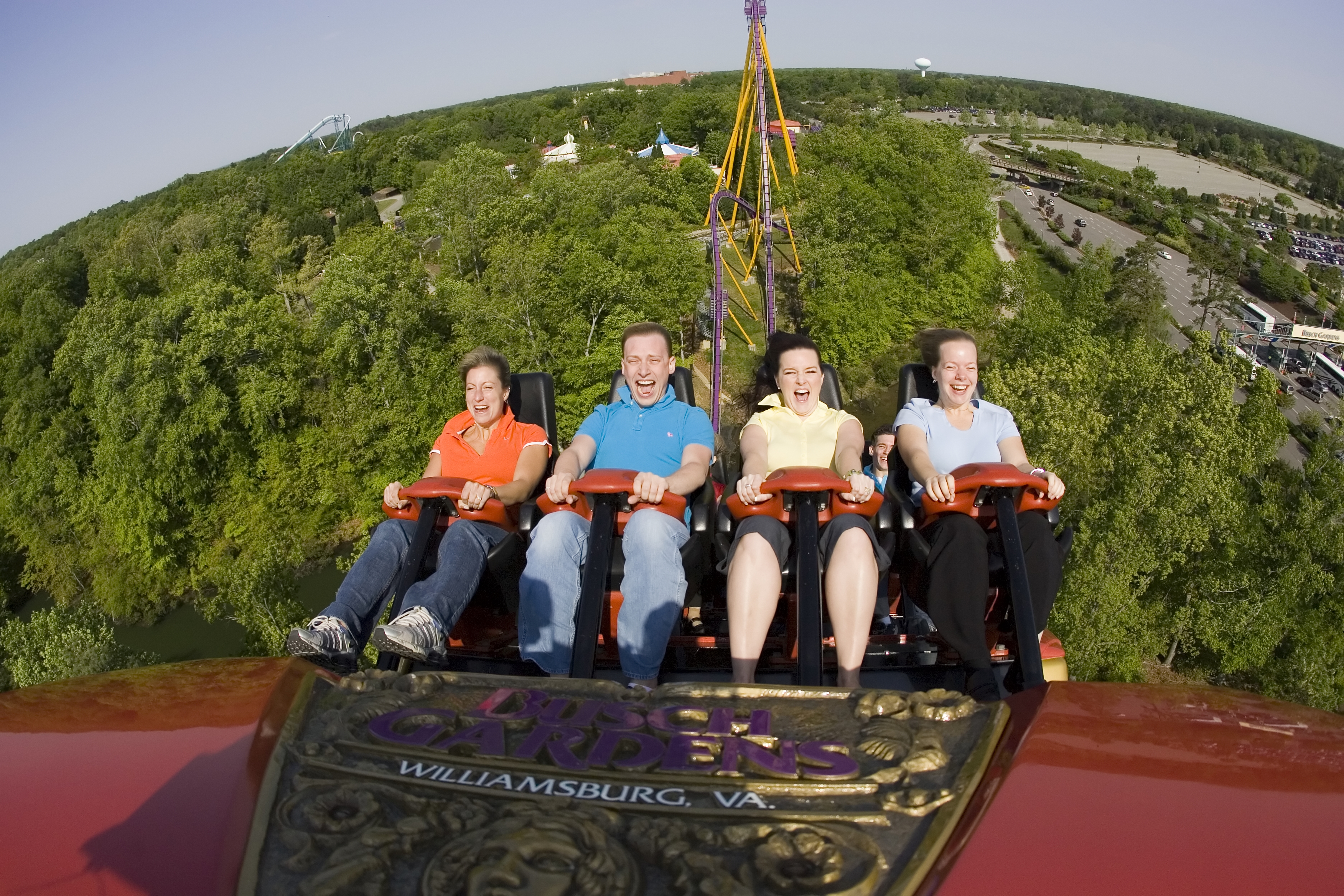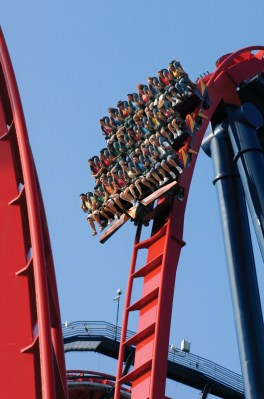We get it. You’ve seen dozens of cheap, page view-grabbing slideshows, read a series of misinformed opinion pieces, and glared at tweets proclaiming Space Mountain the “best ride ever!” You’re upset. We’re upset. It’s time to set the record straight.
At FindTheBest, we rated nearly 500 roller coasters in the United States, combining fan votes, awards, and technical specifications like max height, max speed, track length, G-forces, vertical angles, and inversions. We talked to devoted fans and coaster designers. We even watched helplessly as our personal favorites barely missed out on a top 10 ranking (rest in peace, X2, Six Flags Magic Mountain).
Without further ado, we present the top 10 roller coasters in the nation.
1. Millennium Force, Cedar Point (Sandusky, Ohio)
2. Bizarro, Six Flags New England (Agawam, Massachusetts)
3. Nitro, Six Flags Great Adventure (Jackson, New Jersey)
4. Top Thrill Dragster, Cedar Point (Sandusky, Ohio)
5. The Voyage, Holiday World (Santa Claus, Indiana)
6. El Toro, Six Flags Great Adventure (Jackson, New Jersey)
7. Intimidator 305, Kings Dominion (Doswell, Virginia)
8. Apollo’s Chariot, Busch Gardens Williamsburg (Williamsburg, Virginia)
9. New Texas Giant, Six Flags Over Texas (Arlington, Texas)
10. Intimidator, Carowinds (Charlotte, North Carolina)
Methodology
As always, here’s a breakdown of the methodology.

The Winners
So what can we learn from this list? Which characteristics distinguish the true greats from the average thrill? “A good roller coaster is not about a single gimmick, such as one steep drop,” said Kris Rowberry, who has followed the industry closely for 15 years, visited over 40 theme parks and ridden over 200 roller coasters. Rowberry adheres to a “rule of three,” holding that great coasters must be “well paced,” feature “several good ride elements” and be “easily re-rideable.”

Case in point: the tallest, fastest coaster in the nation (Kingda Ka, Six Flags Great Adventure) did not make our top ten, and none of our picks have a drop “steeper” than 90º. With the notable exception of Top Thrill Dragster (Cedar Point)—which squeezed into the hallowed ten with a combination of top specs and rider votes—most of our top picks have good-but-not-extreme stats, with an average top speed of 81 mph and an average max height of 237 feet. In fact, of all the basic coaster specs (like speed, height, inversions, max vertical angle), the most closely correlated with our top picks was track length. In general, long, varied, and smooth beats quick and extreme.

Still, that isn’t to say that longer is always better. “The ride’s pacing should provide non-stop action from the moment you drop off the lift hill until you return to the relative serenity of the loading platform,” said Paul Ruben, a theme park diehard who has ridden exactly 830 different roller coasters over the course of his life. Like us, he counts Bizarro (Six Flags New England) and Millennium Force (Cedar Point) among his personal top ten, praising the former for providing “so much air time that seats are superfluous” and the latter for “over-banked turns, tunnels,” and four “unforgettable…off-your-seat moments.”
Larry Giles, Vice President of Design and Engineering at Busch Gardens and Water Country USA, weighs in on the careful balance required for great coaster design:
“Height and speed are easily achieved in a coaster, but there is a delicate balance to match. If you make the ride too tall, there is too much energy to dissipate (Kinetic Energy=Mass x Gravity x Height), resulting in a ride that is too long, has large vertical and horizontal curves, and G-forces that are too high.

Giles went on to explain the design process behind Apollo’s Chariot:
The first lift is high and after the lift we placed a section of flat track 50’ long to give the rider anticipation and appreciation of the height, as well as time to evaluate the inevitable—the drop coming. The drop was designed with a vertical curve upwards; as the coaster drops there is an outward force from the seat. While not straight down, the ride will feel near 0G on the drop, the body will sense this in the inner ear and muscular structure. This triggers your natural fight or flight response, or for the coaster rider—a thrill.
The Near Misses

Alas: our top 10 list was bound to stir up controversy. Ruben disagrees with a few of our picks; his personal top 10 places a stronger emphasis on unique attractions that deviate from the predictable coaster blueprint. He praises the seat-rotating X2 (Six Flags Magic Mountain) for “breaking the paradigm of how coasters should work,” and Thunderbolt (Kennywood) for its “one-of-a-kind” design, where the “fiercest drop is at the end. It’s as if the coaster were built backwards.”
Both coasters performed quite well in our rankings: X2 is #22, Thunderbolt is #36 (see the full coaster list here). Just missing our top 10 were favorites like The Beast (a classic wooden coaster in Kings Island with an astonishingly long track of 7,359 feet), Goliath (a smooth-as-silk “hypercoaster” in Six Flags Over Georgia), and even Lake Compounce’s Boulder Dash (an unforgettable journey through a forest of trees…you’ll forget that it never ascends above 50 feet).
“Busch Gardens’ SheiKra is my favorite,” said Michael Mejia, a 13-year-old coaster enthusiast from Michigan. “It has a steep incline, suspends you over the edge which is 200 ft straight down, then drops you.” SheiKra snagged the 43rd slot in our rankings. Mark Rose, Vice President of Engineering at Busch Gardens Tampa, cites SheiKra as a great example of a coaster that might scare first-time riders, but ultimately attract them based on strategic design. “[Our] designers…incorporate viewing vantage points where non-riders who are frightened or intimidated can see the ride and feel the energy.” The best coasters combine a thrilling experience with an external, visual appeal.
The Losers
Gimmicky rides
Toboggan-style rides, wild mouse coasters, launch tracks, and cobra rolls have come and gone over the years as the latest fad, but the traditional, full-circuit coasters have remained the class of the amusement park. Flashy stunts like Six Flags Magic Mountain’s Superman: Escape from Krypton or Knott’s Berry Farm’s Xcelerator grab headlines but fail to leave a lasting impression on riders. Among our top 10, only Top Thrill Dragster has a truly non-traditional style.
Disney
It’s a remarkable company with scenic theme parks and lovable characters. They just don’t make the best roller coasters. Don’t feel bad for Mickey though. While you were reading this article, the company sold 3,560* Donald Duck bobble-head souvenirs (*approximate figure).
Old, rickety rides
There’s a certain charm to the old-fashioned clack of a vintage wooden coaster struggling up the chain lift. Unfortunately, there’s nothing charming about severe whiplash and bruises all over your back. The best classic coasters have been renovated, and the newest, smoothest rides tend to win votes. For the record, our top 10 were all built during or after the year 2000.
The West Coast
Poor California. Despite being home to 36 separate theme parks, only two of the state’s top 50 coasters hail from the Golden State (and none of the 50 are from Oregon or Washington). Perhaps it’s a case of quantity over quality, or else a lack of coaster fervor from a bunch of beach-going, latte-sipping Hollywood elites (disclosure: I live in California). Even Six Flags Magic Mountain’s Goliath failed to beat its eastern rival of the same name, despite being longer, faster, and speedier. Oh well: they’ll always have the year-round temperate weather.
Inversions
Only one coaster in our top 20 (Hades 360, Mt. Olympus Water & Theme Park) has a single corkscrew, loop, or inline twist. “Most inversion elements cannot provide that ‘airtime’ so sought after by roller coaster enthusiasts,” said Rowberry (who, in fairness, loves all coaster types, inversion or no). “The other half of the equation may come down to restraints…many enthusiasts prefer the freedom that a ‘lap bar only’ ride provides them.”
Conclusion
More than anything, fans and experts agree: what’s most important is what riders do right after the ride is over. “The ride should be smooth, and have minimal lateral forces (left and right) on the body and head,” said Rose. “If a rider feels beat up, they will be reluctant to get right back in line.”
“The main objective for the coaster designer,” said Giles, “is to use the tools of G-forces, speed, and the energy to [make] the rider [say,] ‘I just have to do that again!'”
This article was written for TIME by Ben Taylor of FindTheBest.

